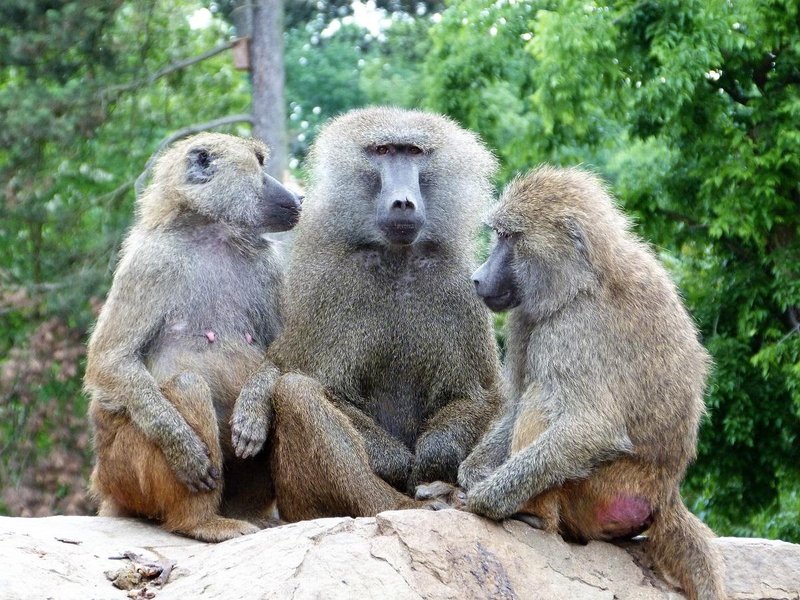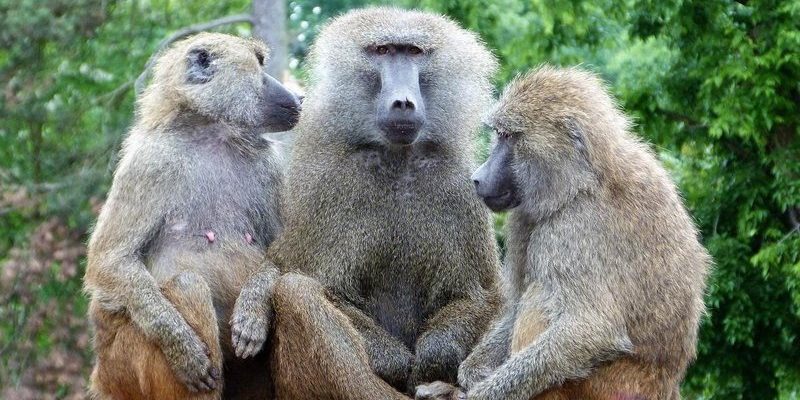
Imagine stumbling upon a lively group of baboons, their playful interactions and distinct personalities drawing your attention. One such fascinating species is the Olive Baboon.
These animals are not just remarkable for their appearance, but also for their behavior, social structures, and adaptability. With a rich history intertwined with human evolution, the Olive Baboon offers a glimpse into the wild side of nature, exhibiting traits that are both impressive and endearing. Let’s dive into the intriguing world of these primates and unravel what makes them so special.
Physical Characteristics
The Olive Baboon stands out with its unique features. On average, adult males can weigh between 80 to 100 pounds, whereas females are smaller, ranging from 50 to 70 pounds. Their body length varies, but they typically stretch about 20 to 30 inches long, excluding their tails, which can add another 25 to 30 inches. The Olive Baboon’s coat is usually a mix of olive green and brown, giving them excellent camouflage in their natural habitat. This coloration helps them blend in with the surroundings, which is especially beneficial for avoiding predators.
One striking characteristic is their elongated muzzles and sharp canine teeth, which not only aid in foraging but also play a role during social interactions. When you see an Olive Baboon, you’re likely to notice its expressive face, full of emotions ranging from curiosity to playfulness. Their eyes are another captivating feature, often reflecting their cheeky personalities. And let’s not forget their long, powerful limbs that help them traverse rocky terrains with ease, as they’re quite the adept climbers!
Overall, the physical traits of the Olive Baboon are a testament to their adaptability and evolutionary success in the wild. Their robust build and clever designs aid them in navigating their habitats, foraging for food, and establishing their ranks within social groups.
Habitat and Distribution
Olive Baboons are found across various parts of Africa, predominantly in the savannas, woodlands, and hillsides. Their range extends from West Africa to East Africa, including countries like Ethiopia, Kenya, and Tanzania. They tend to favor areas with a mix of open ground and trees that provide both foraging opportunities and cover from predators.
These baboons are particularly adept at adapting to different environments. They thrive in habitats where they can find plenty of fruits, seeds, and insects—essential components of their diet. The availability of water sources is also a crucial factor determining their habitat choice. Olive Baboons can often be spotted around rivers and lakes, where they can drink, socialize, and engage in playful behavior.
Another aspect of their habitat is their ability to coexist with human settlements. As they venture into agricultural areas, they sometimes come into conflicts with farmers. However, their intelligence allows them to navigate these challenges, which makes them all the more fascinating. It’s as if they are learning to adapt to human presence while still maintaining their wild essence.
Diet and Feeding Habits
When it comes to meals, Olive Baboons are omnivorous, meaning they munch on a variety of foods. Their diet primarily consists of fruits, seeds, and leaves, but they are also known to indulge in insects, small mammals, and even bird eggs. This diverse menu helps them adapt to the seasonal availability of food in their environment.
One interesting habit is their foraging technique. They often work together in groups, searching for food and sharing their findings. This cooperative behavior not only strengthens social bonds but also increases their chances of locating food in the vast wilderness. You might see them expertly climbing trees or rummaging through bushes, showcasing their dexterous hands and keen eyes.
While Olive Baboons are generally not picky eaters, they do show preferences for certain items based on availability and nutritional needs. For instance, during seasons when fruit is plentiful, you’ll find them feasting on juicy treats, while in drier months, they might rely more on grass and seeds. This adaptability in their diet is key to their survival, especially in fluctuating environments.
Social Structure and Behavior
The social life of Olive Baboons is as vibrant as their personalities. They live in troops that can range from 20 to 100 individuals, and this social structure is crucial for their survival. Troops are led by a dominant male, who maintains his status through displays of strength and aggression. However, it’s not all about fighting. Baboons engage in grooming, which strengthens social bonds and helps reduce stress within the group.
Within these troops, you’ll find a hierarchy that determines access to resources, mates, and even resting spots. Female Olive Baboons often form strong bonds with each other, which can help protect their young from potential threats. It’s interesting to see how these social dynamics play out, with each member taking on roles that contribute to the overall well-being of the troop.
Play is another essential aspect of their behavior. Young Olive Baboons engage in playful antics, learning important life skills while having fun. From chasing each other to mock fighting, this playtime is crucial for their development. Watching these playful interactions gives you a glimpse into their intelligent and curious nature, showcasing the lighter side of life in the wild.
Reproduction and Lifespan
In the world of Olive Baboons, reproduction is a significant event that often involves elaborate courtship behaviors. The females reach sexual maturity around the age of 4 to 5 years, while males usually mature slightly later. During breeding season, males display a range of behaviors to attract females, including vocalizations, facial expressions, and even displays of dominance.
Once a female mates, she has a gestation period of about 6 months, after which she gives birth to a single infant. This infant is highly dependent on its mother for safety and nourishment for the first few months of life. During this time, the mother provides care, grooming, and protection, embedding the importance of maternal bonds in the early stages of development.
Regarding their lifespan, Olive Baboons can live up to 30 years in the wild and even longer in captivity. This longevity depends on various factors, including availability of food, predator presence, and social structure. Understanding their reproductive habits and lifespan provides insight into how these social creatures thrive in their environments.
Conservation Status
While Olive Baboons are not currently classified as endangered, they face threats that could impact their populations. Habitat loss due to agriculture, human encroachment, and urban development poses significant challenges. As their natural habitats shrink, these baboons often find themselves in conflict with humans, especially when foraging for food.
Conservation efforts are essential to protect their natural environments and ensure their survival. Educating local communities about the importance of Olive Baboons and their role in the ecosystem can foster a greater understanding and reduce negative interactions. Programs aimed at preserving their habitats and promoting coexistence can significantly benefit both baboons and the communities around them.
In summary, while Olive Baboons are currently thriving in many regions, proactive measures are necessary to maintain their populations. This ongoing relationship between humans and wildlife highlights the importance of coexistence in today’s world.
Interesting Facts About Olive Baboons
| Scientific Name: | Papio anubis |
| Weight: | 50 to 100 lbs |
| Habitat: | Savannas, woodlands, hillsides |
| Average Lifespan: | Up to 30 years |
| Diet: | Fruits, seeds, insects, small mammals |
| Gestation Period: | Approximately 6 months |
FAQ
What is the social structure of Olive Baboons?
Olive Baboons live in large groups called troops that can contain anywhere from 20 to over 100 individuals. Each troop has a dominant male leader who maintains his status through displays of aggression and strength. Female baboons typically form strong bonds with one another, which aids in their collective nurturing of young and contributes to the troop’s cohesion.
How do Olive Baboons communicate with each other?
Communication among Olive Baboons involves various vocalizations, body language, and facial expressions. They use a combination of calls, grunts, and screams to convey their feelings and needs. Grooming is another essential aspect of their social interaction, helping to solidify bonds and reduce tension within the group.
What do Olive Baboons eat?
As omnivores, Olive Baboons have a varied diet that primarily includes fruits, seeds, leaves, and insects. They are skilled foragers and often work together in groups to find food. This adaptability in diet helps them survive in different environments and during changing seasons.
Do Olive Baboons pose any threat to humans?
While Olive Baboons can sometimes come into conflict with humans, especially when raiding crops, they are generally not aggressive unless provoked. Understanding their behavior and ensuring safe distances can help mitigate any potential threats. Education and community involvement are crucial in promoting coexistence.
How long do Olive Baboons live?
In the wild, Olive Baboons can live up to 30 years, with some individuals living even longer in captivity. Their lifespan is influenced by factors such as food availability, social structure, and the presence of predators, which highlights the importance of a stable environment for their well-being.
Where can I find Olive Baboons in the wild?
You can find Olive Baboons across various regions of Africa, particularly in savannas and woodlands. They are prevalent in countries like Ethiopia, Kenya, and Tanzania. These areas provide the necessary habitat for their foraging and social behaviors.
What threats do Olive Baboons face?
Olive Baboons face threats from habitat loss due to agriculture, urbanization, and human encroachment. These challenges can lead to conflicts with humans and the degradation of their natural environments. Conservation efforts are essential to protect their habitats and ensure their survival.
How do Olive Baboons reproduce?
Female Olive Baboons reach sexual maturity around 4 to 5 years old. After a gestation period of about 6 months, they typically give birth to a single infant. Maternal bonds are strong, and mothers play a crucial role in nurturing and protecting their young during their early stages of life.
Why are Olive Baboons important to their ecosystem?
Olive Baboons play a significant role in their ecosystem by helping to disperse seeds and control insect populations. Their foraging behaviors aid in the growth of plants and contribute to the overall health of their environment. Understanding their role emphasizes the importance of conserving their populations.
Can Olive Baboons be kept as pets?
Keeping Olive Baboons as pets is not advisable. They are wild animals with complex social and behavioral needs that cannot be adequately met in a domestic setting. Furthermore, they require social interactions with their species for healthy development, making them unsuitable as pets.
How do Olive Baboons adapt to their environment?
Olive Baboons are highly adaptable creatures. They can thrive in various habitats by modifying their diet according to seasonal changes and food availability. Their social structures also allow them to work together to find food and protect each other, showcasing their intelligence and resourcefulness.
What is the difference between Olive Baboons and other baboon species?
While there are several baboon species, Olive Baboons are distinguished by their unique coloration, habitat preferences, and social structures. Their adaptability sets them apart, allowing them to inhabit a broader range of environments compared to some other baboon species.

